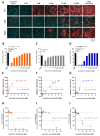Ivermectin Inhibits the Replication of Usutu Virus In Vitro
- PMID: 36016263
- PMCID: PMC9413757
- DOI: 10.3390/v14081641
Ivermectin Inhibits the Replication of Usutu Virus In Vitro
Abstract
Usutu virus (USUV) is an emerging mosquito-borne arbovirus within the genus Flavivirus, family Flaviviridae. Similar to the closely related West Nile virus (WNV), USUV infections are capable of causing mass mortality in wild and captive birds, especially blackbirds. In the last few years, a massive spread of USUV was present in the avian population of Germany and other European countries. To date, no specific antiviral therapies are available. Nine different approved drugs were tested for their antiviral effects on the replication of USUV in vitro in a screening assay. Ivermectin was identified as a potent inhibitor of USUV replication in three cell types from different species, such as simian Vero CCL-81, human A549 and avian TME R. A 2- to 7-log10 reduction of the viral titer in the supernatant was detected at a non-cytotoxic concentration of 5 µM ivermectin dependent on the applied cell line. IC50 values of ivermectin against USUV lineage Africa 3 was found to be 0.55 µM in Vero CCL-81, 1.94 µM in A549 and 1.38 µM in TME-R cells. The antiviral efficacy was comparable between the USUV lineages Africa 2, Africa 3 and Europe 3. These findings show that ivermectin may be a candidate for further experimental and clinical studies addressing the treatment of USUV disease, especially in captive birds.
Keywords: Usutu virus; antiviral; bird; drug; ivermectin.
Conflict of interest statement
The authors declare no conflict of interest.
Figures




Similar articles
-
Epidemic Spread of Usutu Virus in Southwest Germany in 2011 to 2013 and Monitoring of Wild Birds for Usutu and West Nile Viruses.Vector Borne Zoonotic Dis. 2015 Aug;15(8):481-8. doi: 10.1089/vbz.2014.1746. Vector Borne Zoonotic Dis. 2015. PMID: 26273809
-
Different dynamics of Usutu virus infections in Austria and Hungary, 2017-2018.Transbound Emerg Dis. 2020 Jan;67(1):298-307. doi: 10.1111/tbed.13351. Epub 2019 Sep 23. Transbound Emerg Dis. 2020. PMID: 31505099 Free PMC article.
-
Evidence for an independent third Usutu virus introduction into Germany.Vet Microbiol. 2016 Aug 30;192:60-66. doi: 10.1016/j.vetmic.2016.06.007. Epub 2016 Jun 16. Vet Microbiol. 2016. PMID: 27527765
-
Usutu virus: A new threat?Epidemiol Infect. 2019 Jan;147:e232. doi: 10.1017/S0950268819001213. Epidemiol Infect. 2019. PMID: 31364580 Free PMC article. Review.
-
Usutu virus: an emerging flavivirus in Europe.Viruses. 2015 Jan 19;7(1):219-38. doi: 10.3390/v7010219. Viruses. 2015. PMID: 25606971 Free PMC article. Review.
Cited by
-
Broad-Spectrum Antivirals and Antiviral Combinations: An Editorial Update.Viruses. 2022 Oct 14;14(10):2252. doi: 10.3390/v14102252. Viruses. 2022. PMID: 36298807 Free PMC article.
-
Competing interests during the key N-glycosylation of 6-chloro-7-deaza-7-iodopurine for the synthesis of 7-deaza-2'-methyladenosine using Vorbrüggen conditions.Front Chem. 2023 Mar 23;11:1163486. doi: 10.3389/fchem.2023.1163486. eCollection 2023. Front Chem. 2023. PMID: 37035111 Free PMC article.
-
Avermectins Inhibit Replication of Parvovirus B19 by Disrupting the Interaction Between Importin α and Non-Structural Protein 1.Viruses. 2025 Feb 3;17(2):220. doi: 10.3390/v17020220. Viruses. 2025. PMID: 40006975 Free PMC article.
-
Detection of pre-existing neutralizing antibodies against Ad26 in HIV-1-infected individuals not responding to the Ad26.COV2.S vaccine.Infection. 2023 Dec;51(6):1657-1667. doi: 10.1007/s15010-023-02035-6. Epub 2023 Apr 17. Infection. 2023. PMID: 37067754 Free PMC article.
-
Antiviral Chemotherapy in Avian Medicine-A Review.Viruses. 2024 Apr 12;16(4):593. doi: 10.3390/v16040593. Viruses. 2024. PMID: 38675934 Free PMC article. Review.
References
-
- Steinmetz H.W., Bakonyi T., Weissenböck H., Hatt J.-M., Eulenberger U., Robert N., Hoop R., Nowotny N. Emergence and establishment of Usutu virus infection in wild and captive avian species in and around Zurich, Switzerland-genomic and pathologic comparison to other central European outbreaks. Vet. Microbiol. 2011;148:207–212. doi: 10.1016/j.vetmic.2010.09.018. - DOI - PubMed
-
- Cadar D., Lühken R., van der Jeugd H., Garigliany M., Ziegler U., Keller M., Lahoreau J., Lachmann L., Becker N., Kik M., et al. Widespread activity of multiple lineages of Usutu virus, western Europe, 2016. Eurosurveillance. 2017;22:30452. doi: 10.2807/1560-7917.ES.2017.22.4.30452. - DOI - PMC - PubMed
Publication types
MeSH terms
Substances
Supplementary concepts
LinkOut - more resources
Full Text Sources

